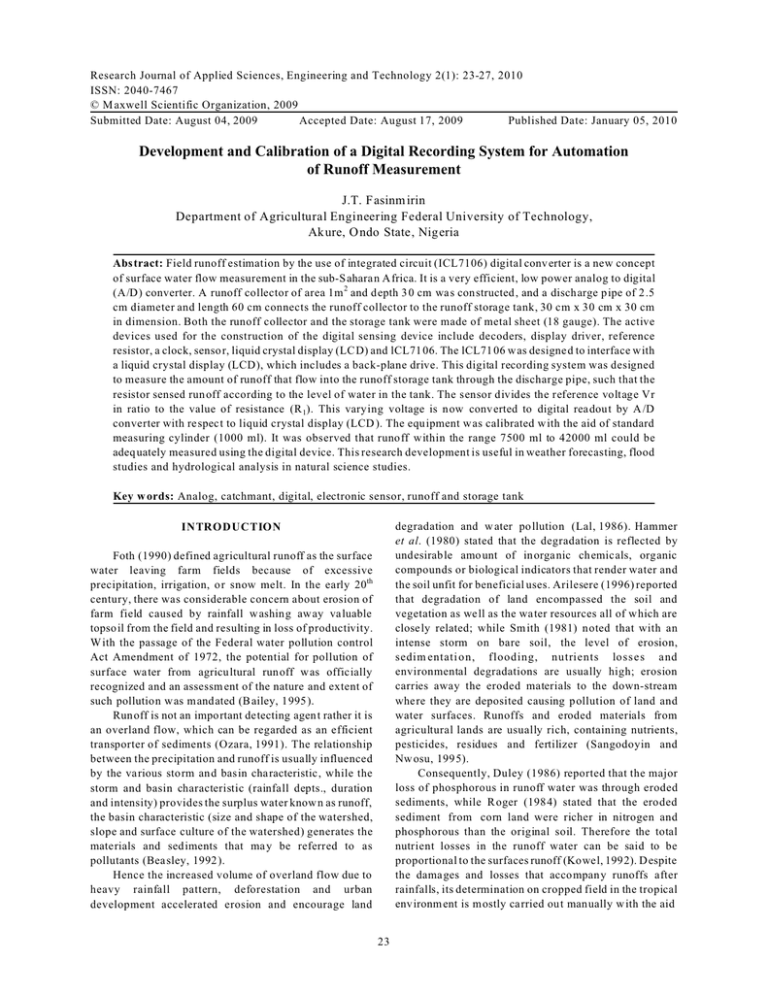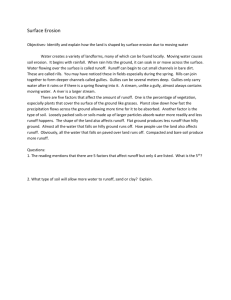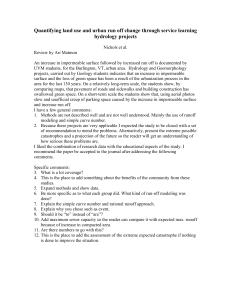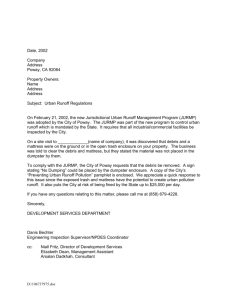Research Journal of Applied Sciences, Engineering and Technology 2(1): 23-27,... ISSN: 2040-7467 © M axwell Scientific Organization, 2009
advertisement

Research Journal of Applied Sciences, Engineering and Technology 2(1): 23-27, 2010 ISSN: 2040-7467 © M axwell Scientific Organization, 2009 Submitted Date: August 04, 2009 Accepted Date: August 17, 2009 Published Date: January 05, 2010 Development and Calibration of a Digital Recording System for Automation of Runoff Measurement J.T. Fasinm irin Department of Agricultural Engineering Federal University of Technology, Akure, O ndo State, Nigeria Abstract: Field runoff estimation by the use of integrated circuit (ICL7106) digital conv erter is a new concept of surface water flow measurement in the sub-S ahara n Africa. It is a very efficient, low power analog to digital (A/D) converter. A runoff collector of area 1m 2 and d epth 3 0 cm was constructed , and a discharge p ipe of 2.5 cm diameter and length 60 cm connects the runoff collector to the runoff storage tank, 30 cm x 30 cm x 30 cm in dimension. Both the runoff collector and the storage tank were made of metal sheet (18 gauge). The active devices used for the construction of the digital sensing device include decoders, display driver, reference resistor, a clock, senso r, liquid crystal display (LC D) and lCL71 06. The lCL71 06 w as designe d to interface with a liquid crystal display (LCD), which includes a back-plane drive. This digital recording system was designed to measure the amount of runoff that flow into the runoff storage tank through the discharge pipe, such that the resistor sensed run off according to the level of water in the tank. The sensor divides the reference voltage Vr in ratio to the value of resistance (R 1). This varying voltage is now conv erted to digital readout by A /D converter with respect to liquid crystal display (LCD ). The equipment w as calibrated w ith the aid of standard measuring cylinder (1000 ml). It was observed that runoff within the range 7500 ml to 42000 ml could be adeq uately measured using the digital device. This research development is useful in weather forecasting, flood studies and hydrological analysis in natural science studies. Key w ords: Analog, catchmant, digital, electronic sensor, runoff and storage tank degradation and w ater pollution (Lal, 1986). Hammer et al. (1980) stated that the degradation is reflected by undesirable amo unt of inorganic chemicals, organic compounds or biological indicators that render water and the soil unfit for beneficial uses. Arilesere (1996) reported that degradation of land encompassed the soil and vegetation as well as the wa ter resources all of w hich are closely related; while Sm ith (1981) noted that with an intense storm on bare soil, the level of erosion, sedim entati on, flooding, nutrients los s e s and environmental degradations are usually high; erosion carries away the eroded materials to the down-stream whe re they are deposited causing pollution of land and water surfaces. Runoffs and eroded materials from agricultural lands are usually rich, containing nutrients, pesticides, residues and fertilizer (Sangodoyin and Nw osu, 1995). Consequently, Duley (1986) reported that the major loss of phosphorous in runoff water was through eroded sediments, while R oger (1984) stated that the eroded sediment from corn land were richer in nitrogen and phosphorous than the original soil. Therefore the total nutrient losses in the runoff water can be said to be proportional to the surfaces runoff (Kowel, 1992). Despite the damages and losses that accompan y runoffs after rainfalls, its determination on cropped field in the tropical environm ent is mostly ca rried ou t manually w ith the aid INTRODUCTION Foth (1990) defined agricultural runoff as the surface water leaving farm fields because of excessive precipitation, irrigation, o r snow melt. In the early 20th century, there was considerable concern about erosion of farm field caused by rainfall w ashing aw ay va luable topsoil from the field and resulting in loss of productivity. W ith the passage of the Federal water pollution control Act Amendment of 1972, the potential for pollution of surface water from agricultural runoff was officially recognized and an assessm ent of the nature and extent of such pollution was mandated (B ailey, 1995). Runoff is not an impo rtant detecting agen t rather it is an overland flow, which can be regarded as an efficient transporter of sediments (Ozara, 1991). The relationship between the precipitation and runoff is usually influenced by the various sto rm an d basin characteristic, while the storm and basin characteristic (rainfall depts., duration and intensity) provides the surplus water know n as runoff, the basin characteristic (size and shape of the watershed, slope and surface culture of the watershed) generates the materials and sediments that ma y be referred to as pollutants (Bea sley, 1992). Hence the increased volume of overland flow due to heavy rainfall pattern, deforestation and urban development accelerated erosion and encourage land 23 Res. J. Appl. Sci. Eng. Technol., 2(1): 23-27, 2010 of measuring cylinders. This method is not only very strenuous; it is also very inaccurate in most cases. This research therefore was aimed at designing a digital electronic sensor for measuring soil and water losses through the process of over land flow. MATERIALS AND METHODS Construction of Runoff-Metre and Installation: The rectangular runoff meter was made from metal sheet (18 gauge), 1m 1m 0.3 m in dimension, it was designed and constructed with the top and the base opened for exposu re to the effe ct of sunlight, precipitation and infiltration into the soil. The runoff meter was installed at a depth of 10 cm into the soil, leaving about 20 cm height above the soil surface. This runoff collector carries overland flow from its catchments and discharge into the runoff storage tank (RST) through a discharge pipe that links the collector to the runoff storage tank. The discharge pipe was made of galvanized steel of 2.5 cm diameter and 50 cm length, the purpose for which is to discharge the collected runoff into the runoff storage tank of dimension 0.60 m x 0.60 m x 0.30 m. T he cove r and base of the storage tank was tightly sealed to prevent any leakage through the system (Fig. 1). The digital sensing device was appropriately installed in other to bring together an unprecedented combination of high accuracy, versatility and true result. In the absence of rainfall, artificial testing and calibration were carried out. Water was gently and continuously applied into the runoff meter in form of shower until the cease of infiltration and the start of runoff from the catchm ent. Immediately runoff gets into the RST, resistor becomes varying and as the resistance varies according to the level of water in the tank; it immediately divides the references voltage (2v) in ratio to the value of resistor R. This varying voltage was converted to digital readout by analog to digital (A/D) con verter (i.e. liquid crystal display). Fig 1: A section of the runoff meter installed on the field General description of the sensor: The intersol ICL7106 is of high performance, low pow er 3½ -digit analog to digital (A/D) converter. All the necessary active devices were contained in a single com plementary metal-oxide semiconductor (CM OS ), including seven segment decoders, display drivers, reference, and a clock. The ICL7106 was designed to interface with a liquid crystal display (LCD ) and includes a back p lane drive. (Cox, 1988).The digital device ICL7106 b rings together an unpredicted combination of high accuracy, versatility and true economy. High accuracy like auto – zero to less than 10µV, input bias current of 10pA maximum, and roll-over error of less than one count. Also, the true economy of single power supply operation (ICL7106) enable a high performance panel meter to be built with the addition of only 7 passive components and a display (Fig. 2). As R is varying according to the lev el of w ater in the tank, it divides the refe rence voltage (2v) in ratio to the value of internal resistance (Ri,). This varying voltage was converted to digital readout by A /D converter. Components Selection: Reference voltage (C alibration): The analog input required to gene rate full-scale output (20 0 cou nts) is V in =2V r. Thus, for the 200 mV and 2.000 -volt sca le, V r shou ld equal 100 mV and 1 volt respectively. Howev er, in much application where the A/D is connected to a transducer, there exists a scale factor other than unity between the input voltage an d the digital reading. For instance, in a weighing system, the voltage from the transducer is 0.682v. Instead of dividing the input down to 200 mV, the input voltage was directly used and V r = 0.341v selected. Suitable value for integrating resistor and capacitor would be 120kw and as a reference a nom inal +2 or -2 volt and analog full-scale integration swing w as selected. Digital sensing device: Features: The features of the digital sensing device include: C C C C C C C C C C Guaranteed zero read ing for 0 volt input True polarity at zero for precise null deflection 1 pA input current True differential input and reference Direct display drive- no external compo nents required –LCD ICL7106 Low noise – less than 15µV Chip clock and reference Low power dissipation – typically less than 10mW No additional active circuit required Evaluation kit available Auto- Zero and Reference Capacitor: The size of the auto-zero capacitor has some influence on the noise of the system. For 200 mV full scale, where noise is mostly experienced, 0.47 µF capacitor was selected. On the volt scale, a 0.47 µF capacitor increases the speed of recovery 24 Res. J. Appl. Sci. Eng. Technol., 2(1): 23-27, 2010 Fig. 2: The ICL7106 with Liquid Crystal Display from overload and is adequate for noise on this scale. Reference capacitor gives good results in most application. However, where a large common mode voltage exists (i.e. the reference voltage is not at analog) and a 200mV scale is used, a higher valu e reference capa citor may be required to prev ent roll over error. Generally 1.0 µF will hold the rollover error to 0.5 count in this instance. RESULTS AND DISCUSSION Performance Test and Calibration of Runoff Meter: The result of the calibrations carried out on the runo ff sensor equipment is presented in Fig. 3–6. The sensor reading increases with increase in water depth in the runoff storage tank. However, w ater depth from zero to 7499 ml in the runoff storage tank (RST) was not enough to lift the sensor arm and hence, no sensor measurement was recorded until the 7500 ml depth of water in the tank. The corresponding sensor measurement at the instance of 7500 ml was 8002.1 ml, while at the 40000 ml level; the sensor reading w as 4108 3.85 ml du ring the first calibration exercise. The minimum and maximum sensor readings during the second calibration were 7965 and Integrating Resistor and Capacitor: Both the buffer amplifier and the integrator have a c lass A output stage with 10 µA of quiescent current. They can supply 20 µA of drive current with negligible non-linearity. The integrating resistor w as high eno ugh to remain in this very linear region over the input voltage range, but small enough that undue leakage req uirem ents are not placed on the printed circuit (PC) board. The integration capacitor was selected to give the maxim um v oltage swin g that ensures tolerance build-up will not saturate the integrator swing (appro x. 0.3 volt. from either supply) in ICL7106 while using the analog common. Statistical Analysis: Runoff data obtained from b oth the digital runoff meter and cylinder measuremen ts were subjected to statistical analysis and the corresponding coefficients of determina tions from linear and quad ratic mod els were generated. Th e standard error SE from the linear and quadratic models was determined to suggest which of the model is best under the prevailing soil and climate condition. Fig 3: Runoff curve during the Ist calibration of the digital sensor (linear fit) 25 Res. J. Appl. Sci. Eng. Technol., 2(1): 23-27, 2010 Fig. 4: Runoff curve during the Ist calibration of the digital sensor (quadrartic fit) Fig. 7: Regression curve of the 1st and 2nd calibration of the digital sensor How ever, the difference in CV is not significant at p < 0.05. A regression of the cylinder and the sensor readings during the first calibration suggest that there were no significant difference at the p = 0.05 and p = 0.01. How ever, the difference were highly significant at p < 0.0001, with r (Pearson) = 0.97 from the linear fit (Table 1). Ho wever, the quad ratic fit gave a sligh tly higher Pearson co efficient of correlation (r) = 0.98. Similar observations were recorded during the second calibration. The linear an d quadratic fits gave r = 0.97 and 0.98, respectively. The relationship between observed sensor readings during the first and th e second calibrations gave a high coefficient of determination r 2 = 0.99 (Fig. 7), which almost approach unity. The regression plot so obtained reflects the consistency level of the sensor equipment in the measurement of runoff. Re-sampling t-test of the first and second calibrations in ten simulations showed that the measured general average and deviation were 23397.01 ml and ± 95.13, respectively. The statistically simulated general average and deviation were 24097.43 ml and ± 79.61, respectively. Fig. 5: Runoff curve during the second calibration of the digital sensor (linear fit) CONCLUSION The design analysis, and construction of digital sensing devices for runoff measurement has been presented. It consist of runoff catchment bo x (basin), runoff storage tank ((RST), discharge pipe, digital devices such as ICL7106 analog to digital converter, resistor, liquid crystal display (LCD), sensor (floater), Pressure hose, 6F 2.29V battery, among others. All the materials used for the fabrication were sourced locally. The calibration was performed such that the initial water level in the runoff storage tank must reach 7500 ml to activate the sensor. The use of digital ICL7106 ana log to digital Fig. 6: Runoff curve during the second calibration of the digital sensor (quadrartic fit) 40945.76 ml, respectively. The coefficients of variation (CV) of sensor read ings during the first and second calibrations were 42.82 and 42.58%, respectively, comp aratively with the low er coefficient of variation (41.41 %) obtained under the cylinder measuremen t. 26 Res. J. Appl. Sci. Eng. Technol., 2(1): 23-27, 2010 Tab le 1: S um mar y of calib ration statistics for th e ma nua l and sen sor m easu rem ents 1 st calibration ----------------------------------------------------------Statistics M inim um (ml) M inim um (ml) CV% SE r2 r(Pearson) (p) RE Manu al 7500 40000 41.41 1703.58 Sensor 80 02 .1 41083.85 42.82 1721.82 0.94 0.97* <0.0001 Y=1440.12+0.962X converter for measuring the amount of runoff at all period of time brings together an accuracy, versatility and economical method of estimating runoff. 2 n d calibration -------------------------------------------------------------------Manu al Manu al 7500 7965 40000 40945.76 41.41 42.58 1703.58 1705.18 0.95 0.97* <0.0001 Y=1246.86+0.974X Duley, F.L., 1986. The loss of soluble salts runoff w ater. Soil Sci., 21: 401-409. Foth, H.D., 1990. Fundamental of Soil Science. Eight Editions. John Wiley & Son Inc. New York, NY. Ham mer, M.J. and K.A. Machinechkn, 1980. Hydrology and Quality of Water Resources. John Wiley and Sons. New Y ork. Kow el, J., 1992. The hydrology of a sm all catchmen t’s basin of Sam aru, N igeria: A ssessmen t of soil erosion under varied hand management and vegetation cover. Nigerian Agric. J., 7: 134-138. Lal, R., 1986. Soil erosion problems on an alfosol in western nigeria and their control, lll A M onograph, 1: 4-10. Ozara, A., 1991. Management and Control of Erosion Process Institute of Erosion Studies Hand Book. Federal University of Technology Owerri, 1: 100-101. Roger, H.T ., 1984 . Plant nutrient losses from a corn wheat clover rotation on dune m ore silts-lea ns soil. Soil Sci. Soc. Amer. Proc., 6: 263-265. Sangodoyin, A.U. and E.O. Nwosu, 1995. Time variation and soil loss with soil ph ysical prope rties in southeastern Nigeria. J. Agric. Eng . Tech nol., 3: 66-69. Smith, N.J.H., 1981. Colonization Lessons from a Tropical Forest Science. 214: 753-761. Nom enclatures: ICL7106 Integrated Circuit 7106 A/D Analog to Digital CMOS Com plemen tary meta-oxide Semiconductor Vr Reference Voltage Ri Internal Resistance LCD Liquid Crystal Display PC b oard Printed Circuit Board C Capacitance V in Input Voltage RST Runoff Storage Tank REFERENCES Arilesere, F., 1996. Erosion as the major cause of land degradation. Ultimate W ater Te chnol. Environ., 1(1): 5-7. Bailey, R.G., 1995. Description of the Eco-regions of the United State. 2nd Edn., United State Department of Agriculture, Forest Services, Washington DC. Beasley, R.P., 1992. Erosion and sediment pollution control. lowa State University press, Iowa, USA. Cox, S.W.R., 1988. Farm Electronics, BSP Professional Books. A D ivision of Blackw ell Scien tific P u b l i c at i o n s L td . B eacon Street, B osto n Massachesetts 02108, USA., pp: 171-174. 27







